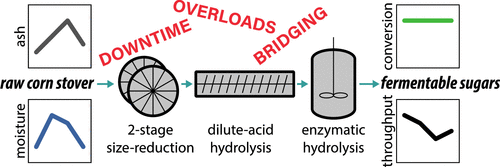当前位置:
X-MOL 学术
›
ACS Sustain. Chem. Eng.
›
论文详情
Our official English website, www.x-mol.net, welcomes your
feedback! (Note: you will need to create a separate account there.)
Throughput, Reliability, and Yields of a Pilot-Scale Conversion Process for Production of Fermentable Sugars from Lignocellulosic Biomass: A Study on Feedstock Ash and Moisture
ACS Sustainable Chemistry & Engineering ( IF 7.1 ) Pub Date : 2020-01-24 , DOI: 10.1021/acssuschemeng.9b06550 David A. Sievers 1 , Erik M. Kuhn 1 , Vicki S. Thompson 2 , Neal A. Yancey 3 , Amber N. Hoover 4 , Michael G. Resch 1 , Edward J. Wolfrum 5
ACS Sustainable Chemistry & Engineering ( IF 7.1 ) Pub Date : 2020-01-24 , DOI: 10.1021/acssuschemeng.9b06550 David A. Sievers 1 , Erik M. Kuhn 1 , Vicki S. Thompson 2 , Neal A. Yancey 3 , Amber N. Hoover 4 , Michael G. Resch 1 , Edward J. Wolfrum 5
Affiliation

|
Early lignocellulosic biorefineries have been plagued with numerous issues that involve feedstock handling problems and variations in conversion efficacy that stem from feedstock variability and complexity in dimensional, physical, chemical, and mechanical attributes. Feedstock ash and moisture content vary considerably in corn stover harvested from farms for bioconversion, and their effects on preprocessing (grinding/milling) and subsequent chemical and enzymatic conversion to fermentable sugars is systematically explored here using pilot-scale hammer mill grinders and a chemical hydrolysis reactor. Corn stover with high ash content due to contamination from soil was found to (1) consume higher power during grinding resulting in reductions of processing rates and (2) produce a larger fraction of fines in the feedstock that were lost to dust mitigation systems causing higher mechanical wear rates. Corn stover feedstock coming from fields with a high residual moisture content resulting in bale degradation due to self-heating caused a more pronounced drop in preprocessing throughput due to grinder overloads and process upsets leading to equipment downtime. Conversion yield to sugars was not affected, although differences in fermentation performance on these sugar streams was not examined. The overall process throughput was only 40–70% of nameplate capacity due to preprocessing problems.
中文翻译:

从木质纤维素生物质生产可发酵糖的中试转化过程的通量,可靠性和产率:原料灰分和水分的研究
早期的木质纤维素生物提炼厂一直困扰着许多问题,这些问题涉及原料处理问题和转化效率的变化,这些问题源于原料在尺寸,物理,化学和机械特性方面的可变性和复杂性。从农场收获的用于生物转化的玉米秸秆中的原料灰分和水分含量差异很大,这里使用中试规模的锤磨机和化学水解系统地研究了它们对预处理(研磨/碾磨)以及随后的化学和酶促转化为可发酵糖的影响。反应堆。发现由于土壤污染而导致灰烬含量高的玉米秸秆(1)在研磨过程中消耗较高的功率,从而导致加工速率降低;(2)原料中产生较大比例的细粉,这些细粉由于减尘系统损失而导致机械磨损率。玉米秸秆原料来自具有高残留水分的田地,由于自热而导致棉包降解,这是由于磨机过载和工艺不正常而导致设备停工,从而导致预处理产量的下降更为明显。尽管未检查这些糖料流上发酵性能的差异,但转化为糖的收率没有受到影响。由于预处理问题,整个过程的吞吐量仅为铭牌容量的40–70%。玉米秸秆原料来自具有高残留水分的田地,由于自热而导致棉包降解,这是由于磨机过载和工艺不正常而导致设备停工,从而导致预处理产量的下降更为明显。尽管未检查这些糖料流上发酵性能的差异,但转化为糖的收率没有受到影响。由于预处理问题,整个过程的吞吐量仅为铭牌容量的40–70%。玉米秸秆原料来自具有高残留水分的田地,由于自热而导致棉包降解,这是由于磨机过载和工艺不正常而导致设备停工,从而导致预处理产量的下降更为明显。尽管未检查这些糖料流上发酵性能的差异,但转化为糖的收率没有受到影响。由于预处理问题,整个过程的吞吐量仅为铭牌容量的40–70%。尽管未检查这些糖流的发酵性能差异。由于预处理问题,整个过程的吞吐量仅为铭牌容量的40–70%。尽管未检查这些糖流的发酵性能差异。由于预处理问题,整个过程的吞吐量仅为铭牌容量的40–70%。
更新日期:2020-01-24
中文翻译:

从木质纤维素生物质生产可发酵糖的中试转化过程的通量,可靠性和产率:原料灰分和水分的研究
早期的木质纤维素生物提炼厂一直困扰着许多问题,这些问题涉及原料处理问题和转化效率的变化,这些问题源于原料在尺寸,物理,化学和机械特性方面的可变性和复杂性。从农场收获的用于生物转化的玉米秸秆中的原料灰分和水分含量差异很大,这里使用中试规模的锤磨机和化学水解系统地研究了它们对预处理(研磨/碾磨)以及随后的化学和酶促转化为可发酵糖的影响。反应堆。发现由于土壤污染而导致灰烬含量高的玉米秸秆(1)在研磨过程中消耗较高的功率,从而导致加工速率降低;(2)原料中产生较大比例的细粉,这些细粉由于减尘系统损失而导致机械磨损率。玉米秸秆原料来自具有高残留水分的田地,由于自热而导致棉包降解,这是由于磨机过载和工艺不正常而导致设备停工,从而导致预处理产量的下降更为明显。尽管未检查这些糖料流上发酵性能的差异,但转化为糖的收率没有受到影响。由于预处理问题,整个过程的吞吐量仅为铭牌容量的40–70%。玉米秸秆原料来自具有高残留水分的田地,由于自热而导致棉包降解,这是由于磨机过载和工艺不正常而导致设备停工,从而导致预处理产量的下降更为明显。尽管未检查这些糖料流上发酵性能的差异,但转化为糖的收率没有受到影响。由于预处理问题,整个过程的吞吐量仅为铭牌容量的40–70%。玉米秸秆原料来自具有高残留水分的田地,由于自热而导致棉包降解,这是由于磨机过载和工艺不正常而导致设备停工,从而导致预处理产量的下降更为明显。尽管未检查这些糖料流上发酵性能的差异,但转化为糖的收率没有受到影响。由于预处理问题,整个过程的吞吐量仅为铭牌容量的40–70%。尽管未检查这些糖流的发酵性能差异。由于预处理问题,整个过程的吞吐量仅为铭牌容量的40–70%。尽管未检查这些糖流的发酵性能差异。由于预处理问题,整个过程的吞吐量仅为铭牌容量的40–70%。









































 京公网安备 11010802027423号
京公网安备 11010802027423号